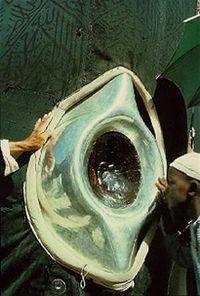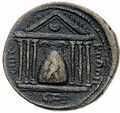Black Stone
This article or section is being renovated. Lead = 4 / 4
Structure = 3 / 4
Content = 3 / 4
Language = 3 / 4
References = 4 / 4
|
The Black Stone (ٱلْحَجَرُ ٱلْأَسْوَد, al-Hajr al-Aswad) is a rock that was embedded into the east-facing corner of the Ka'bah, which is located in Mecca and is the "house of God" towards which Muslims pray five times a day. According to historians, the Black Stone was one of many baetyls employed to idolatrous ends by pre-Islamic Arab pagans, who used the Ka'bah as a pagan shrine in which were housed some 360 idols. The hadith tradition agrees that the stone was already part of the Ka'bah before Muhammad was born during the time of the pagan Arabs. The hadith tradition, however, asserts that the stone descended from heaven along with Adam and Eve and was incorporated into the structure of the Ka'bah when it was supposedly built by the prophet Ibrahim and his son Isma'il.[1] Muhammad was said to have reset the stone into the Ka'bah when the Ka'bah had been destroyed and rebuilt by the Meccans prior to Muhammad's proclamation of prophethood.
During the Hajj pilgrimage, while circumambulating the Ka'bah (tawaf), Muslims are instructed by scripture to kiss, touch, or at least point to the black stone if possible in order to secure blessings. In addition to the wear from this practice by hundreds of millions of pilgrims, the Black Stone has been victim to the structural fate of the Ka'bah, which, throughout history, has been demolished, bombarded and reconstructed several times. At one point, the Black Stone was struck by a stone launched from a catapult and smashed to pieces.[2] On other occasions, the Black Stone is reported to have been defiled with excrement, robbed by the Qarmatians, and otherwise deliberately abused.[3][4][5][6]
Beyond the assertions of the Saudi government, the continued existence of the original Black Stone, its origins, and the historicity of whatever is currently remains contained in the silver protrusion on the side of the Ka'bah have not been independently verified.[7] Nonetheless, the Natural Museum of History in the United Kingdom has suggested that the stone is likely a pseudometeorite, or a terrestrial rock mistaken for a meteorite, that was first sacralized by the pagan Arabs.[8] There is likewise no historical evidence to suggest that Ibrahim and Isma'il were responsible for the construction of the Ka'bah or, therefore, the original placement of the Black Stone.
As a baetyl of the pagan Arabs
Most historians consider the Black Stone to be an Arabian baetyl from pre-Islamic times. The Encyclopedia Britannica defines 'baetyl' as "In Greek religion, a sacred stone or pillar. The word baetylus is of Semitic origin (-bethel). Numerous holy, or fetish, stones existed in antiquity, generally attached to the cult of some particular god and looked upon as his abiding place or symbol".[9] The Encyclopedia continues:
Arabian religion, Encyclopædia Britannica, 2009
According to Ibn Ishaq, one of the earliest biographers of Muhammad, the Black Stone was important to the Arabian polytheists prior to Muhammad's prophethood. In a famous tale from the sira, Muhammad was requested by the Quraysh to help mediate on how the Black Stone was to be restored to the Ka'bah as it was being reconstructed.
فَزَعَمَ بَعْضُ أَهْلِ الرِّوَايَةِ: أَنَّ أَبَا أُمِّيَّةَ بْنَ الْمُغِيرَةِ بْنِ عَبْدِ اللَّهِ بْنِ عُمَر بْنِ مَخْزُومٍ -وكان عامئذ أسن قُرَيْشٍ كُلِّهِمْ -قَالَ(١١٠) : يَا مَعْشَرَ قُرَيْشٍ، اجْعَلُوا بَيْنَكُمْ فِيمَا تَخْتَلِفُونَ فِيهِ أَوَّلَ مَنْ يَدْخُلُ مِنْ بَابِ هَذَا الْمَسْجِدِ، يَقْضِي بَيْنَكُمْ، فِيهِ. فَفَعَلُوا، فَكَانَ أَوَّلُ دَاخِلٍ رَسُولَ اللَّهِ ﷺ. فَلَمَّا رَأَوْهُ قَالُوا: هَذَا الْأَمِينُ رَضِينَا، هَذَا مُحَمَّدٌ، فَلَمَّا انْتَهَى إِلَيْهِمْ وَأَخْبَرُوهُ الْخَبَرَ، قَالَ [رَسُولُ اللَّهِ](١١١) ﷺ: "هَلُمَّ إليَّ ثَوْبًا" فَأُتِي بِهِ، فَأَخَذَ الرُّكْنَ -يَعْنِي الْحَجَرَ الْأَسْوَدَ-فَوَضَعَهُ فِيهِ بِيَدِهِ، ثُمَّ قَالَ: "لِتَأْخُذْ كُلُّ قَبِيلَةٍ بِنَاحِيَةٍ مِنَ الثَّوْبِ"، ثُمَّ [قَالَ](١١٢) : "ارْفَعُوهُ جَمِيعًا". فَفَعَلُوا، حَتَّى إِذَا بَلَغُوا بِهِ مَوْضِعَهُ، وَضَعَهُ هُوَ بِيَدِهِ ﷺ، ثُمَّ بَنَى عَلَيْهِ. وَكَانَتْ قُرَيْشٌ تُسَمِّي رَسُولَ اللَّهِ ﷺ قَبْلَ أَنْ يَنْزِلَ عَلَيْهِ الْوَحْيُ: الْأَمِينُ.
Ibn Ishaq said, "The tribes of Quraysh collected stones to rebuild the House, each tribe collecting on their own. They started rebuilding it, until the rebuilding of the Ka`bah reached the point where the Black Stone was to be placed in its designated site. A dispute erupted between the various tribes of Quraysh, each seeking the honor of placing the Black Stone for their own tribe. The dispute almost led to violence between the leaders of Quraysh in the area of the Sacred House. Banu `Abd Ad-Dar and Banu `Adi bin Ka`b bin Lu'ay, gave their mutual pledge to fight until death. However, five or four days later, Abu Umayyah bin Al-Mughirah bin `Abdullah bin `Amr bin Makhzum, the oldest man from Quraysh then intervened at the right moment. Abu Umayyah suggested that Quraysh should appoint the first man to enter the House from its entrance to be a mediator between them. They agreed.
The Messenger - Muhammad - was the first person to enter the House. When the various leaders of Quraysh realized who the first one was, they all proclaimed, `This is Al-Amin (the Honest one). We all accept him; This is Muhammad.' When the Prophet reached the area where the leaders were gathering and they informed him about their dispute, he asked them to bring a garment and place it on the ground. He placed the Black Stone on it. He then requested that each of the leaders of Quraysh hold the garment from one side and all participate in lifting the Black Stone, moving it to its designated area. Next, the Prophet carried the Black Stone by himself and placed it in its designated position and built around it. The Quraysh used to call the Messenger of Allah `Al-Amin' even before the revelation came to him."See alternatively Ibn Ishaq; Ibn Hisham, A. Guillaume, ed, Sirat Rasul Allah [The Life of Muhammad], Karachi: Oxford UP, p. 86, ISBN 0196360331, 1955, https://archive.org/details/GuillaumeATheLifeOfMuhammad/page/n65/mode/2up
Other baetyls of the pagan Arabs
The black stone was not the only important stone in Arabia. Historians have pointed out how other Arabian centers were host to their own Ka'bahs, often having their own divine stones of various colors.
The Black Stone of Eloh
Ancient writers Herodian and Cassius Dio mention a temple in Syrian city of Emesa (today known as Hims or Homs). A local Semitic god named Eloh (meaning Lord) was worshipped there. He was known to Romans and Greeks as Heliogabalus, a corrupted garbling of Eloh Gabal (Lord of Mountain, one of Eloh’s titles). Eloh was associated with sun and thus identified with Roman god Sol and Greek Helios.
In the temple one of the holiest relics of antiquity, the Black Stone, was kept. It was believed to come from outside earth (possibly a meteorite) and to be a manifestation of Eloh himself. Faithful from the entire Roman orient made pilgrimage to the stone. They brought valuable gifts and offerings. The followers of Eloh obeyed ritualistic rules. For instance, they were required to be circumcised and were not allowed to eat pork.
This cult was one of many thousands in the ancient Mediterranean and would likely have been forgotten were it not for a certain dramatic and favorable occurrence. In 218 AD, a young priest of that temple and a Roman citizen--Varius Avitus Bassus--was prompted by his power-hungry family to usurp the throne of Rome by claiming to be an illegitimate son of the murdered emperor Caracalla (who ruled 211-217). Successful in his usurpation, Varius Avitus Bassus ruled for four years and was thereafter remembered by his nickname–also the name of his god–Elagabalus.
Elagabalus was generally considered to have been an exceptionally perverted ruler. He was reported to have prostituted himself in the imperial palace and had numerous wives and husbands at the same time. He was widely known as an unapologetic masochist, allowing everyone to beat him. Many of Elagabalus's attributed his debauchery and lack of decorum to what they considered to be the corrupting influence of the cult of the deity Eloh.
The young emperor brought his famous Black Stone to Rome. He wanted to make the worship of Eloh either supreme or the only religion of the Roman Empire. This caused uproar among Romans. Every year in summer a procession foreign and unknown to locals was held. The Black Stone was placed on a chariot with reins attached to it (suggesting that the god himself was coaching). The emperor would walk afoot near the chariot. Senators, notable citizens, parade of soldiers, musicians and exotic animals followed.
After four years of rule which disturbed many Romans, Elogabalus was murdered by soldiers. His body was thrown to river Tiber. [10]
Hadith
2. Ibn `Abbas (may Allah be pleased with him) also narrated that the Prophet (peace and blessings be upon him) said: “When the Black Stone came down from Paradise, it was whiter than milk, but the sins of the sons of Adam made it black.” (At-Tirmidhi, Sunan)
3. Ibn `Abbas (may Allah be pleased with him) further related that the Prophet (peace and blessings be upon him) said: “By Allah, Allah will bring it forth on the Day of Judgment, and it will have two eyes with which it will see and a tongue with which it will speak, and it will testify in favor of those who touched it in sincerity.” (At-Tirmidhi, Sunan)
4. Ibn `Umar (may Allah be pleased with him) quoted the Prophet (peace and blessings be upon him) as saying: “Touching them both (the Black Stone and Ar-Rukn Al-Yamani) is an expiation for one’s sins.” (At-Tirmidhi, Sunan, hadith no. 959. This hadith is classified as hasan by At-Tirmidhi and as Sahih by Al-Hakim (1/664), and Adh-Dhahabi agreed with him.)
(The aforementioned hadiths were quoted from a fatwa by the prominent Saudi scholar Sheikh Muhammad Salih Al-Munajjid, www.islam-qa.com)Islam Online, Fatwa Bank, January 8, 2003
Shaykh Gibril Fouad Haddad, Living Islam, April 11, 2000
External Links
References
- ↑ Sheikh Ahmad Kutty - The Black Stone: History & Significance - Islam Online, January 8, 2003
- ↑ Hırka-i Saadet Dairesi; Hilmi Aydın(2004) - The sacred trusts: Pavilion of the Sacred Relics, Topkapı Palace Museum, Istanbul - Tughra Books, ISBN 9781932099720
- ↑ Burton, Richard Francis (1856) - Personal narrative of a pilgrimage to El-Madinah and Meccah - G. P. Putnam & Co., p. 394
- ↑ Francis E. Peters (1994) - Mecca: a literary history of the Muslim Holy Land - Princeton University Press, pp. 125–126, ISBN 9780691032672
- ↑ Cyril Glasse - New Encyclopedia of Islam: A Revised Edition of the Concise Encyclopedia of Islam (p. 245) - Rowman Altamira, 2001, ISBN 0759101906
- ↑ Black Stone of Mecca - Encyclopædia Britannica, 2007
- ↑ Maria Golia, Meteorite: Nature and Culture, Reaktion Books, ISBN 978-1780235479, 2015, https://www.google.com/books/edition/Meteorite/oiTNCgAAQBAJ?hl=en&gbpv=1&bsq=Wabar+meteorite+craters+black+stone&pg=PT68&printsec=frontcover
- ↑ Monica M. Grady; A.L. Graham, Catalogue of meteorites: with special reference to those represented in the collection of the Natural History Museum, London, Cambridge University Press, p. 263, ISBN 978-0-521-66303-8, 2000
- ↑ Baetylus Encyclopædia Britannica, 2009
- ↑ Poczet Cesarzy Rzymskich (In English: Roman Emperors), by Aleksander Krawczuk




